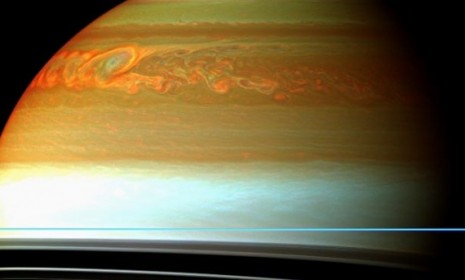Saturn's swirling megastorm that's bigger than multiple Earths
In 2010, astronomers spotted the beginnings of a massive maelstrom that has grown to encircle the ringed planet

East Coasters panicked by this weekend's oncoming Frankenstorm haven't seen anything yet. New readings from NASA's Cassini orbital spacecraft have discovered that a massive maelstrom first spotted on Saturn in 2010 was more intense than initially thought. The gigantic, swirling beast ballooned to 180,000 miles in length — many times the size of Earth — and, according to a new study, was seeing wild temperature fluctuations to the tune of 150 degrees Fahrenheit. Here, a brief guide to the ringed planet's megastorm:
How big was it?
Really, really big. To get a better idea of how vast 180,000 miles is, consider that Earth's diameter is just 7,926 miles. First spotted two years ago by amateur astronomers as a distinct white spot in Saturn's northern hemisphere, the storm grew to be larger than Earth in a few short weeks. After three months, it had wrapped completely around the planet, thanks to strong atmospheric winds. By that time, the gigantic weather anomaly had an "unprecedented temperature spike that released tons of energy, equivalent to an enormous planetary belch," says Adam Mann at Wired. By mid-2011, the superstorm began to recede and "the teeth had been taken out of it," says Phil Plait at Discover Magazine. But it still had "one surprise left in it."
The Week
Escape your echo chamber. Get the facts behind the news, plus analysis from multiple perspectives.

Sign up for The Week's Free Newsletters
From our morning news briefing to a weekly Good News Newsletter, get the best of The Week delivered directly to your inbox.
From our morning news briefing to a weekly Good News Newsletter, get the best of The Week delivered directly to your inbox.
What was the surprise?
Inside the giant storm was a swirling, powerful vortex — a storm within a storm. Inside the vortex, temperatures surged 150 degrees Fahrenheit above normal, a change "so extreme it's almost unbelievable," says study lead author Brigette Hesman of the University of Maryland and NASA's Goddard Space Flight Center. "To get a temperature change of the same scale on Earth, you'd be going from the depths of winter in Fairbanks, Alaska, to the height of summer in the Mojave Desert."
So the vortex was burning hot?
Not exactly. "It's not like it was a firestorm," says Discover Magazine's Plait. The temperature was still a "chilly" -238 degrees Fahrenheit — but that's considerably warmer than Saturn's usual -364 degrees.
A free daily email with the biggest news stories of the day – and the best features from TheWeek.com
What was it like inside the storm?
The storm, which was the largest recorded tempest since 1903, emitted an explosive amount of ethylene, a colorless and odorless gas not typically seen on Saturn, says Wired's Mann. Inside it was likely an "odd soupy mixture," producing 100 times more ethylene than scientists thought the planet was capable of.
Sources: Discover Magazine, Space.com, Universe Today, Wired


